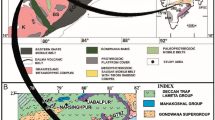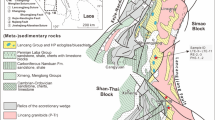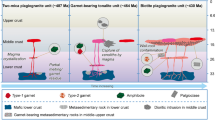Abstract
The Puu Oo eruption has been remarkable in the historical record of Kilauea Volcano for its duration (over 13 years), volume (>1 km3) and compositional variation (5.7–10 wt.% MgO). During the summer of 1986, the main vent for lava production moved 3 km down the east rift zone and the eruption style changed from episodic geyser-like fountaining at Puu Oo to virtually continuous, relatively quiescent effusion at the Kupaianaha vent. This paper examines this next chapter in the Puu Oo eruption, episodes 48 and 49, and presents new ICP-MS trace element and Pb-, Sr-, and Nd-isotope data for the entire eruption (1983–1994). Nearly aphyric to weakly olivine-phyric lavas were erupted during episodes 48 and 49. The variation in MgO content of Kupaianaha lavas erupted before 1990 correlates with changes in tilt at the summit of Kilauea, both of which probably were controlled by variations in Kilauea's magma supply rate. These lavas contain euhedral olivines which generally are in equilibrium with whole-rock compositions, although some of the more mafic lavas which erupted during 1990, a period of frequent pauses in the eruption, accumulated 2–4 vol.% olivine. The highest forsterite content of olivines (∼85%) in Kupaianaha lavas indicates that the parental magmas for these lavas had MgO contents of ∼10 wt.%, which equals the highest observed value for lavas during this eruption. The composition of the Puu Oo lavas has progressively changed during the eruption. Since early 1985 (episode 30), when mixing between an evolved rift zone magma and a more mafic summit reservoir-derived magma ended, the normalized (to 10 wt.% MgO) abundances of highly incompatible elements and CaO have systematically decreased with time, whereas ratios of these trace elements and Pb, Sr, and Nd isotopes, and the abundances of Y and Yb, have remained relatively unchanged. These results indicate that the Hawaiian plume source for Puu Oo magmas must be relatively homogeneous on a scale of 10–20 km3 (assuming 5–10% partial melting), and that localized melting within the plume has apparently progressively depleted its incompatible elements and clinopyroxene component as the eruption continued. The rate of variation of highly incompatible elements in Puu Oo lavas is much greater than that observed for Kilauea historical summit lavas (e.g., Ba/Y 0.09 a–1 vs ∼0.03 a–1). This rapid change indicates that Puu Oo magmas did not mix thoroughly with magma in the summit reservoir. Thus, except for variable amounts of olivine fractionation, the geochemical variation in these lavas is predominantly controlled by mantle processes.
Similar content being viewed by others
Author information
Authors and Affiliations
Additional information
Received: 8 March 1996 / Accepted: 30 April 1996
Rights and permissions
About this article
Cite this article
Garcia, M., Rhodes, J., Trusdell, F. et al. Petrology of lavas from the Puu Oo eruption of Kilauea Volcano: III. The Kupaianaha episode (1986–1992). Bull Volcanol 58, 359–379 (1996). https://doi.org/10.1007/s004450050145
Issue Date:
DOI: https://doi.org/10.1007/s004450050145




